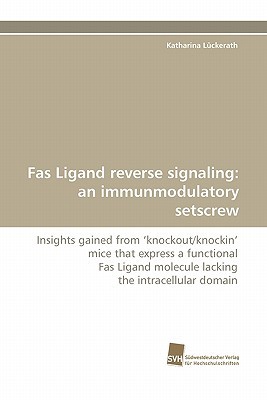
- We will send in 10–14 business days.
- Author: Katharina L Ckerath
- Publisher: Sudwestdeutscher Verlag Fur Hochschulschriften AG
- Year: 2011
- Pages: 144
- ISBN-10: 3838124871
- ISBN-13: 9783838124872
- Format: 15.2 x 22.9 x 0.9 cm, softcover
- Language: English
- SAVE -10% with code: EXTRA
Reviews
Description
Binding of Fas Ligand (FasL) to the Fas receptor triggers apoptosis of the receptor-bearing cell, which plays a pivotal role for homeostasis of the immune system and during acute immune responses. Similar to other TNF family members, the intracellular FasL domain is able to transmit signals into the FasL-bearing cell ("reverse signaling"). Recently, we have described a Notch-like proteolytic processing of FasL by the proteases ADAM10 and SPPL2a, which leads to the release of the intracellular domain (FICD) into the cytoplasm. Following the cleavage event, FICD translocates to the nucleus and influences gene transcription. To study the physiological importance of FasL reverse signaling in vivo on the level of the endogenous proteins, we have established a knockout/knockin mouse model in which wildtype FasL was replaced with a deletion mutant lacking the intracellular portion (FasL∆Intra). Our ex vivo and in vivo findings demonstrate that FasL reverse signaling is a negative modulator of certain immune responses. It is tempting to speculate that FasL reverse signaling might be a fine-tuning mechanism to prevent autoimmune diseases.
EXTRA 10 % discount with code: EXTRA
The promotion ends in 20d.02:50:59
The discount code is valid when purchasing from 10 €. Discounts do not stack.
- Author: Katharina L Ckerath
- Publisher: Sudwestdeutscher Verlag Fur Hochschulschriften AG
- Year: 2011
- Pages: 144
- ISBN-10: 3838124871
- ISBN-13: 9783838124872
- Format: 15.2 x 22.9 x 0.9 cm, softcover
- Language: English English
Binding of Fas Ligand (FasL) to the Fas receptor triggers apoptosis of the receptor-bearing cell, which plays a pivotal role for homeostasis of the immune system and during acute immune responses. Similar to other TNF family members, the intracellular FasL domain is able to transmit signals into the FasL-bearing cell ("reverse signaling"). Recently, we have described a Notch-like proteolytic processing of FasL by the proteases ADAM10 and SPPL2a, which leads to the release of the intracellular domain (FICD) into the cytoplasm. Following the cleavage event, FICD translocates to the nucleus and influences gene transcription. To study the physiological importance of FasL reverse signaling in vivo on the level of the endogenous proteins, we have established a knockout/knockin mouse model in which wildtype FasL was replaced with a deletion mutant lacking the intracellular portion (FasL∆Intra). Our ex vivo and in vivo findings demonstrate that FasL reverse signaling is a negative modulator of certain immune responses. It is tempting to speculate that FasL reverse signaling might be a fine-tuning mechanism to prevent autoimmune diseases.


Reviews